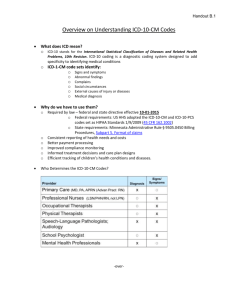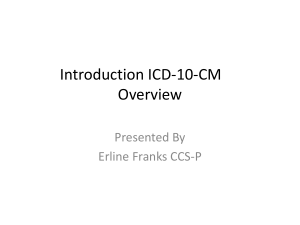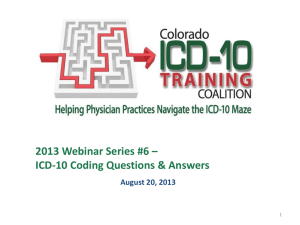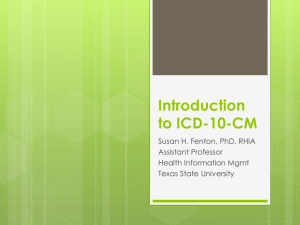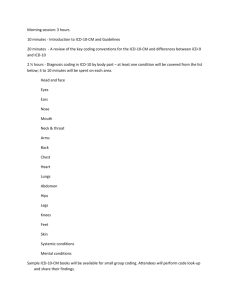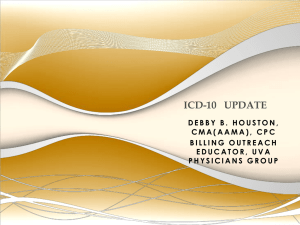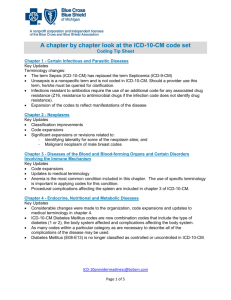Basic Differences Between ICD-9-CM and ICD-10-CM
advertisement
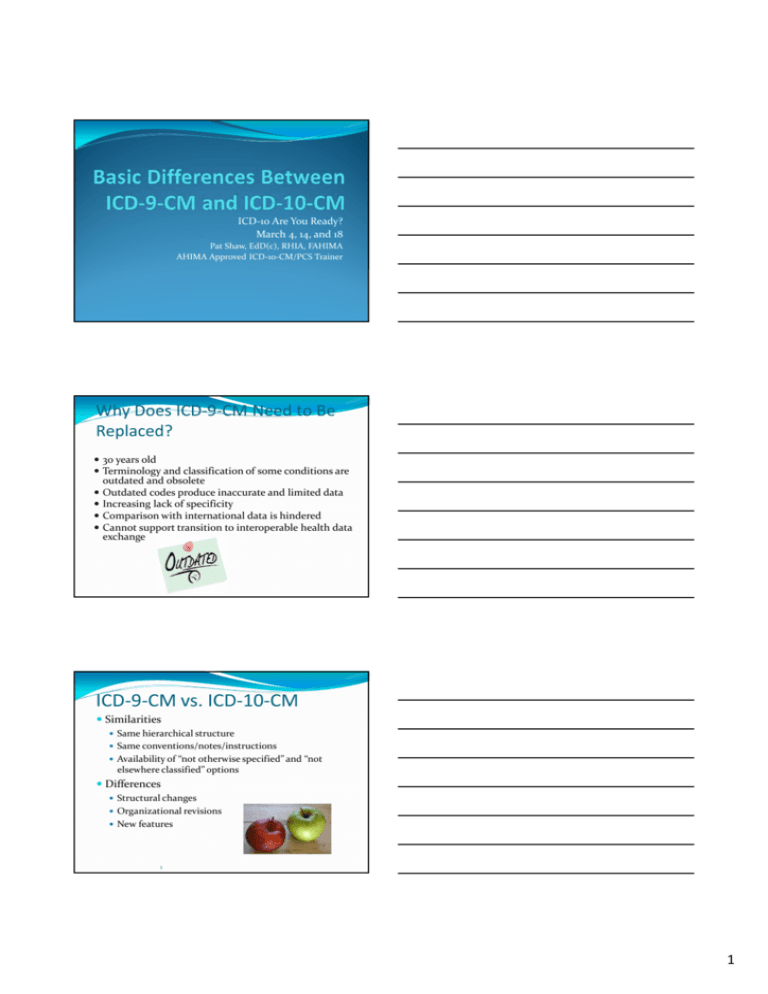
ICD-10 Are You Ready? March 4, 14, and 18 Pat Shaw, EdD(c), RHIA, FAHIMA AHIMA Approved ICD-10-CM/PCS Trainer Why Does ICD-9-CM Need to Be Replaced? 30 years old Terminology and classification of some conditions are outdated and obsolete Outdated codes produce inaccurate and limited data Increasing lack of specificity Comparison with international data is hindered Cannot support transition to interoperable health data exchange 2 ICD-9-CM vs. ICD-10-CM Similarities Same hierarchical structure Same conventions/notes/instructions Availability of “not otherwise specified” and “not elsewhere classified” options Differences Structural changes Organizational revisions New features 3 1 Differences in ICD-10-CM Alphanumeric (alpha characters are not case-sensitive) Some chapters have been restructured Certain diseases have been reclassified to reflect current medical knowledge New features have been added Specificity and detail have been significantly expanded 4 ICD-10-CM Structural Changes 21 chapters Full code titles for all codes (no references back to common 4th and 5th digits) Addition of 6th and 7th characters in some chapters Added code extensions (7th character) for obstetrics, injuries, and external causes of injury 5 ICD-10-CM Structural Changes Addition of dummy place holder (“x”) Dummy place holder “x” Used as 5th character for some 6 character codes For future expansion Example: T51.0x1A Toxic effect of ethanol, accidental (unintentional), initial encounter X11.1xxA Contact with running hot water, initial encounter W00.0xxD Fall on same level due to ice and snow, subsequent encounter 6 2 2nd Numeric 3rd – 7th Numeric or Alpha 1st - Alpha (Except U) M X X A S 0 X 2 . Category Additional Characters X 6 X 5 X A X Etiology, anatomic site, severity Added seventh characters for obstetrics, injuries, and external causes of injury 3 – 7 Characters 7 © 2014 ICD-10-CM Full Code Titles ICD-9-CM 143 Malignant neoplasm of gum 143.0 Upper gum 143.1 Lower gum ICD-10-CM C03 Malignant neoplasm of gum C03.0 Malignant neoplasm of upper gum C03.1 Malignant neoplasm of lower gum 8 ICD-10-CM New Features Combination codes for conditions and common symptoms or manifestations Combination codes for poisonings and external causes Added laterality Expanded codes (injury, diabetes, alcohol/substance abuse, postoperative complications) 9 3 ICD-10-CM New Features Inclusion of trimester in obstetrics codes (and elimination of 5th digits for episode of care) Revised diabetes mellitus codes to reflect current ADA classification Changes in time frames specified in certain codes External Cause codes no longer a supplementary classification Added standard definitions for two types of Excludes notes 10 ICD-10-CM Excludes Notes Excludes1 Means NOT CODED HERE Code being excluded is never used with code The two conditions cannot occur together Example: B06 Rubella [German measles] Excludes1: congenital rubella (P35.0) 11 ICD-10-CM Excludes Notes Excludes2 Means NOT INCLUDED HERE Excluded condition is not part of the condition represented by the code Acceptable to use both codes together if patient has both conditions Example: J04.0 Acute laryngitis Excludes2: chronic laryngitis (J37.0) 12 4 ICD-10-CM Injury Changes ICD-9-CM Fractures (800-829) Dislocations (830-839) Sprains and strains(840-848) ICD-10-CM Injuries to the head (S00-S09) Injuries to the neck (S10-S19) Injuries to the thorax (S20-S29) 13 ICD-10-CM Examples – Code Extensions S31.623A Laceration with foreign body of abdominal wall, right lower quadrant with penetration into peritoneal cavity, initial encounter S49.011D Salter-Harris Type I physeal fracture of upper end of humerus, right arm, subsequent encounter for fracture with routine healing S49.011G Salter-Harris Type I physeal fracture of upper end of humerus, right arm, subsequent encounter for fracture with delayed healing 14 ICD-9-CM Open Wound of Shoulder 880 Open wound of shoulder and upper arm 880.0 Without mention of complication 880.1 Complicated 880.2 With tendon involvement 5th digit for site (shoulder, axillary, upper arm) 15 5 ICD-10-CM Open Wound of Shoulder Detail for open wounds added at 5th character, laterality at 6th, and encounter at 7th character: 16 ICD-10-CM Diabetes Mellitus Changes Updated to reflect current clinical classification of diabetes Old classification: insulin-dependent (IDDM), noninsulin-dependent (NIDDM), gestational New classification: type 1, type 2, due to underlying condition, drug or chemical induced, other specified types, gestational Expanded code descriptions to include diabetes and manifestation in single code 17 ICD-9-CM Diabetes Mellitus 250.00-250.91 Diabetes mellitus 251.8 Other specified disorders of pancreatic internal secretion 648.8x Abnormal glucose tolerance complicating pregnancy, childbirth, or the puerperium 18 6 ICD-10-CM Diabetes Mellitus - Examples E09.01 Drug or chemical induced diabetes mellitus with hyperosmolarity with coma E10.11 Type 1 diabetes mellitus with ketoacidosis with coma E11.40 Type 2 diabetes mellitus with diabetic nephropathy, unspecified E13.621 Other specified diabetes mellitus with foot ulcer 19 ICD-10-CM Diabetes Mellitus - Examples 20 ICD-9-CM Decubitus Ulcer 707.00-707.09 Decubitus ulcer Site-specific codes No laterality No differentiation by severity 21 7 ICD-10-CM Decubitus Ulcer L89.001-L89.94 Decubitus ulcer Site-specific codes Includes laterality Includes severity (depth) Limited to breakdown of skin, fat layer exposed, necrosis of muscle, necrosis of bone 22 ICD-10-CM Decubitus Ulcer ICD-10-CM Obstetrics Addition of trimester and deletion of episode of care O15.02 Eclampsia in pregnancy, second trimester O60.3 Preterm labor, third trimester 24 8 ICD-10-CM Obstetrics Trimester also identified in “encounter for supervision of normal pregnancy codes” Z34.00-Z34.93) Encounter for supervision of high-risk pregnancy has been moved to OB chapter Weeks of Gestation – Category Z3A Identifies the specific week of pregnancy ICD-10-CM Obstetrics Definition changes Abortion vs Fetal Death 20 weeks instead of 22 weeks Early vs late vomiting 20 weeks instead of 22 Preterm labor 37 completed weeks of gestation ICD-10-CM Obstetrics Code extensions to identify specific fetus (1-5) affected by obstetric condition Elective, legal, or therapeutic abortions are not classified to the abortion codes (code Z33.2, Encounter for elective termination of pregnancy) Obstructed labor codes incorporate reason for obstruction Additional codes for OB complications 27 9 ICD-9-CM Postoperative Complications Heart failure following cardiac surgery 429.4 Functional disturbances following cardiac surgery 997.1 Cardiac complications Use additional code to identify complication Postoperative intestinal obstruction 997.4 Digestive system complications Use additional code to identify complication 28 ICD-10-CM Postoperative Complications Heart failure following cardiac surgery Postoperative intestinal obstruction 29 ICD-10-CM Symptoms, Signs, Abnormal Findings Symptom chapter is limited to signs/symptoms that are “not otherwise specified,” “unknown etiology,” or “transient” Signs/symptoms that point to diagnoses are assigned to relevant chapter 30 10 ICD-10-CM Reason for Encounter Personal history of malignant neoplasm Primary Secondary In situ (breast only) Uncertain behavior 31 ICD-10-CM Reason for Encounter Presence of artificial joint By site Laterality Case 1 75-year-old woman receiving continued care for multiple facial lacerations, abrasions, and contusions. She was previously treated in the ER for these injuries. 11 Case 1 ICD-9-CM V58.89 Encounters for procedures and aftercare ICD-10-CM S01.81xD Laceration w/o foreign body of other part of head, subsequent encounter X58.xxxD Accident, NOS, subsequent encounter Case 2 Patient presents for results of an MRI of the right knee, has severe pain and inability to descend stairs. She fell while running in the park. MRI showed complex medial meniscus tear and a Baker’s cyst, along with mild chondromalacia of the patella. Options for treatment were discussed and the patient will determine what she’d like to do. ICD-9-CM 836.0 Tear of medical cartilage/meniscus of knee, current E885.9 Fall on same level from slipping/tripping/stumbling E849.4 Injury or poisoning occurring at/in place for recreation and sport E001.1 Activities involving running E000.8 External cause status 727.51 Synovial cyst of popliteal space 717.7 Chondromalacia of patella 12 ICD-10-CM S83.231A Tear, torn (traumatic) meniscus (knee) (current injury), medial, complex M71.21 Baker’s cyst – see Cyst, Baker’s M22.41 Chondromalacia (systemic), patella W19.xxxA Index to External Causes – Fall, falling (accidental) Y92.830 Index to External Causes – Place of occurrence, park (public) Y93.02 Index to External Causes – Activity (involving) running Y99.8 Index to External Causes – External cause status, leisure activity Case 3 A patient is seen in the hospital with a diagnosis of congestive heart failure due to hypertensive heart disease. The patient responds positively to Lasix therapy. The patient also has chronic kidney disease stage 5. ICD-9-CM 404.93 Hypertensive heart and chronic kidney disease stage V or end state renal disease, with heart failure, unspecified benign or malignant 585.5 Chronic kidney disease, stage V 428.0 Congestive heart failure, unspecified 13 ICD-10-CM I13.2 Hypertensive heart and chronic kidney disease with heart failure and with stage 5 chronic kidney disease, or end state renal disease I50.9 Heart failure, unspecified N18.5 Chronic kidney disease, stage 5 Case 4 This woman is G1P0 at 39 weeks with twin gestation. The delivery was complicated by nuchal cord, without compression, of fetus 2. Both infants were liveborn and healthy. ICD-9-CM 651.01 Twin pregnancy, delivered 663.31 Other and unspecified cord entanglement, without mention of compressions, delivered V27.2 Mother with twins, both liveborn 14 ICD-10-CM O30.003 Twin pregnancy, unspecified number of placenta and unspecified number of amniotic sacs, third O69.81x2 Labor and delivery complicated by cord around neck, without compression, fetus 2 Z37.2 Outcome of delivery, twins, both liveborn Z3A.39 39 weeks of gestation pregnancy Case 5 55 year old male was admitted for OT following hospitalization for type I open traumatic fracture of the left radius and ulna. ICD-9-CM V57.21 Encounter for Occupational Therapy V54.12 Aftercare for healing traumatic fracture of lower arm 15 ICD-10-CM S52.92xE Fracture, traumatic, radius S52.202E Fracture, traumatic, ulna X58.xxxD Index to External Cause, accident The OT would be captured in the procedure code Case 6 This type 1 diabetic patient has a severe chronic diabetic left foot ulcer with diabetic peripheral angiopathy. He also has diabetic stage 2 chronic kidney disease. He is being evaluated to see if debridement is required for this ulcer with breakdown of the skin. ICD-9-CM 250.81 Diabetes mellitus with specified manifestation, type I (juvenile type), not stated as uncontrolled 707.15 Ulcer of foot (toes) 250.71 Diabetes mellitus with peripheral circulatory disorder, type I (juvenile type), not stated as uncontrolled 443.81 Peripheral angiopathy in diseases classified elsewhere 250.41 Diabetes mellitus with renal manifestations, type I (juvenile type), ), not stated as uncontrolled 585.2 Chronic kidney disease, stage II (mild) 16 ICD-10-CM E10.621 Type 1 diabetes mellitus with foot ulcer L97.521 Non-pressure chronic ulcer of other part of left foot limited to breakdown of skin E10.51 Type 1 diabetes mellitus with diabetic peripheral angiopathy without gangrene E10.22 Type 1 diabetes mellitus with diabetic chronic kidney disease N18.2 Chronic kidney disease, stage 2 (mild) Impact on Specialties Orthopedic Injuries, Gustilo classification, encounters, no aftercare codes for injuries Obstetrics Trimesters, weeks of gestation, 7th characters for fetus Questions 17
